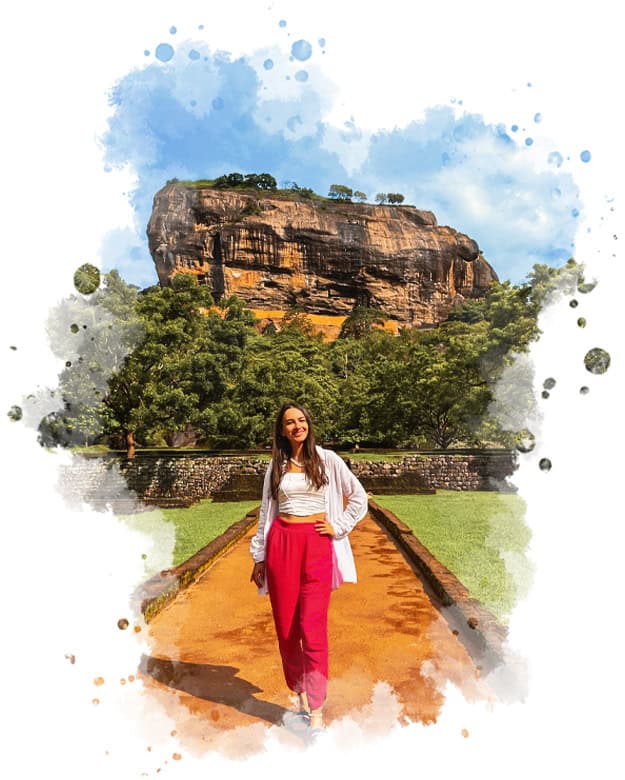
Sigiriya, Sri Lanka
Things to do, weather & itineraries
Situated in the northeast of Sri Lanka, the little town of Sigiriya is home to the locally dubbed “eighth wonder of the world”—an ancient fortress built atop a rocky outcrop in the centre of the cultural triangle. Surrounded by ruins that carry tales of the Sinhalese kings and their feats, Sigiriya’s attractions showcase the country’s Buddhist identity as well as the mastery of its early architects, making the region a must-see on every itinerary.
Apart from the rock fortress, which boasts of traditional art and architecture that can be explored on foot, Sigiriya’s attractions lie outside the town limit. Its other activities include a visit to the Dambulla Cave Temple to uncover the long-standing relationship between history and religion, and a jeep safari in the Minneriya National Park to watch the country’s largest gathering of elephants.
The average daytime temperatures in Sigiriya range from 24°C to 31.5°C (75.2°F to 88.7°F), making it one of the hotter places to see in Sri Lanka. Despite this, the best time to visit the region is during its dry season, which extends from mid-December to mid-April, and from July to September.
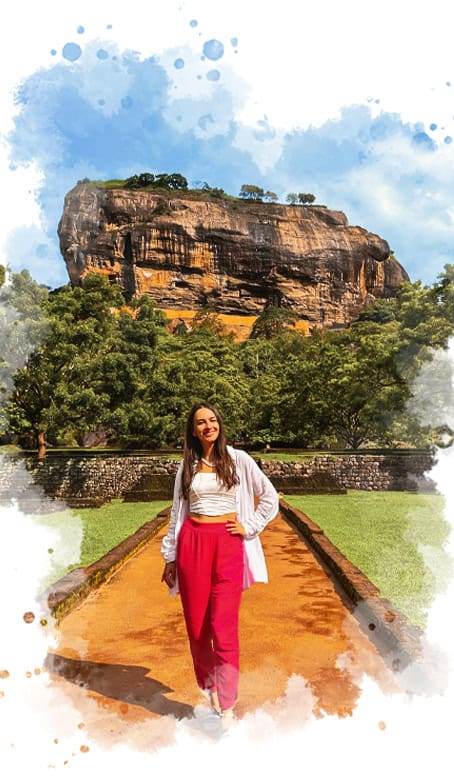
Sigiriya, Sri Lanka
Things to do, weather & itineraries
Situated in the northeast of Sri Lanka, the little town of Sigiriya is home to the locally dubbed “eighth wonder of the world”—an ancient fortress built atop a rocky outcrop in the centre of the cultural triangle. Surrounded by ruins that carry tales of the Sinhalese kings and their feats, Sigiriya’s attractions showcase the country’s Buddhist identity as well as the mastery of its early architects, making the region a must-see on every itinerary.
Apart from the rock fortress, which boasts of traditional art and architecture that can be explored on foot, Sigiriya’s attractions lie outside the town limit. Its other activities include a visit to the Dambulla Cave Temple to uncover the long-standing relationship between history and religion, and a jeep safari in the Minneriya National Park to watch the country’s largest gathering of elephants.
The average daytime temperatures in Sigiriya range from 24°C to 31.5°C (75.2°F to 88.7°F), making it one of the hotter places to see in Sri Lanka. Despite this, the best time to visit the region is during its dry season, which extends from mid-December to mid-April, and from July to September.
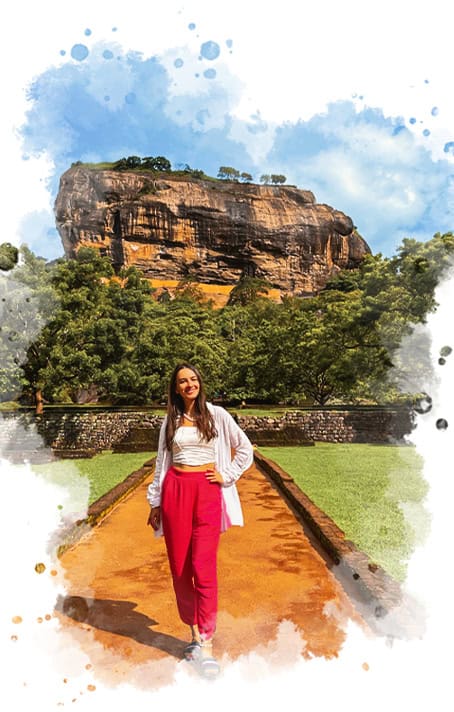
Sigiriya, Sri Lanka
Things to do, weather & itineraries
Situated in the northeast of Sri Lanka, the little town of Sigiriya is home to the locally dubbed “eighth wonder of the world”—an ancient fortress built atop a rocky outcrop in the centre of the cultural triangle. Surrounded by ruins that carry tales of the Sinhalese kings and their feats, Sigiriya’s attractions showcase the country’s Buddhist identity as well as the mastery of its early architects, making the region a must-see on every itinerary.
Apart from the rock fortress, which boasts of traditional art and architecture that can be explored on foot, Sigiriya’s attractions lie outside the town limit. Its other activities include a visit to the Dambulla Cave Temple to uncover the long-standing relationship between history and religion, and a jeep safari in the Minneriya National Park to watch the country’s largest gathering of elephants.
The average daytime temperatures in Sigiriya range from 24°C to 31.5°C (75.2°F to 88.7°F), making it one of the hotter places to see in Sri Lanka. Despite this, the best time to visit the region is during its dry season, which extends from mid-December to mid-April, and from July to September.
Tour itineraries featuring Sigiriya
As mentioned before, the main excursions that you can enjoy during your stay in Sigiriya are the Sigiriya Rock Fortress, the Dambulla Cave Temple, and the Minneriya National Park. For some guidance on how you can fit Sigiriya into your tour of Sri Lanka, please refer to the sample itineraries below.
Tour itineraries featuring Sigiriya
As mentioned before, the main excursions that you can enjoy during your stay in Sigiriya are the Sigiriya Rock Fortress, the Dambulla Cave Temple, and the Minneriya National Park. For some guidance on how you can fit Sigiriya into your tour of Sri Lanka, please refer to the sample itineraries below.

Sri Lanka with Toddlers
Enjoy the best of Sri Lanka with your little ones. A slow-paced family holiday for people travelling with toddlers.

Sri Lanka Culture Trip
Discover the Magical beauty and the rich culture of Sri Lanka with our well-designed Sri Lanka culture trips.
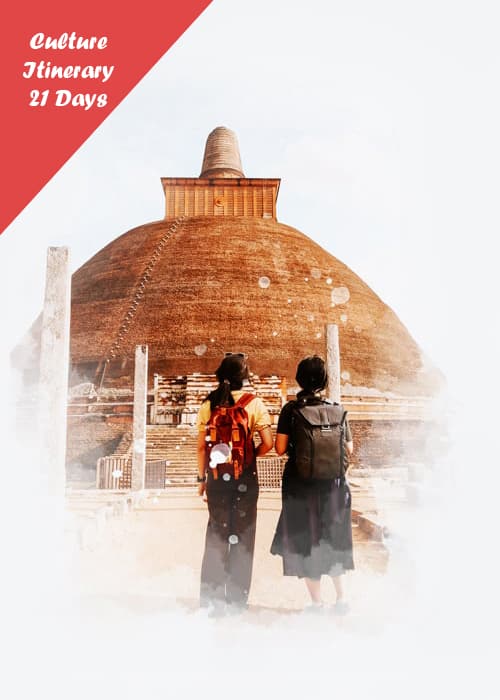
Sri Lanka in 3 Weeks
Enjoy the wildlife, nature, culture, history, and the local life of Sri Lanka with a perfect three-week Sri Lanka holiday.
Request a Free Quotation
Would you like to get our assistance to organize your Sri Lanka holiday? Drop us a message to get a tailor-made Sri Lanka holiday package that reflects your interests, budget, tour duration and the weather conditions of the month that you visit Sri Lanka.
Things to do in Sigiriya
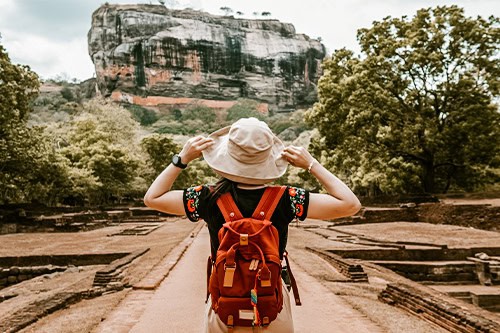
The first stop on most tour itineraries in Sigiriya is the famed rock fortress— a UNESCO World Heritage Site that rises above the surrounding plains at a height of around 200 metres (656 ft). Steeped in a tale of lethal ambition, the fortress is regarded as the pinnacle of local architecture, boasting an artful design with an advanced irrigation system that forms one of Sri Lanka’s most iconic attractions.
Historical records have revealed that the fortress was constructed in the aftermath of a violent power struggle between Kashyapa, the son of a non-royal concubine, and his father, King Dhatusena. With the aid of his father’s army commander, Kashyapa ascended the throne and entombed Dhatusena in a wall while the rightful heir, Moggallana, fled to India for protection.
Despite his best efforts, Kashyapa was rejected by his subjects, who could not forgive him for his involvement in Dhatusena’s death. Kashyapa then moved the royal capital to Sigiriya and built the fortress for his protection. However, his reign was not meant to last as Moggallana returned for revenge, causing the king to commit suicide. The fortress was then converted into a monastery until foreign invasions led to its abandonment. Today, it remains as proof of Kashyapa’s former glory.
While there is plenty to see within the fortress, it is best known for its frescoes that offer insight into traditional art. Regarded as one of the oldest picture galleries in the world, these frescoes depict women whose identities are unknown, but many believe that they may have been goddesses, Kashyapa’s daughters, or the 500 concubines of his harem. The very existence of these paintings suggests that the king may have modelled Sigiriya after Alakamanda, or the city of gods from Buddhist mythology.
The fortress also has a reputation for its landscaped gardens, which are one of the oldest of their kind. While its boulder and terraced gardens are certainly a sight to behold, the water gardens are the most magnificent, as they rely on an advanced hydraulic system in which rainwater is distributed throughout the palace grounds, ensuring that the fortress’ pools and streams are always full.
Moreover, the three-metre-high (10ft) Mirror Wall was once a polished surface on which Kashyapa would gaze at his own reflection. The inscriptions on this wall contain evidence of Sigiriya’s culture and community, as well as poetry and prose penned by the many visitors who journeyed to the fortress between the 6th and the 14th centuries.
Climbing the 1200 steps of the Sigiriya fortress is a moderately difficult task, and it requires a minimum of 3 hours to be toured at a leisurely pace. Travellers Isle recommends visiting as early as 7AM with a local guide who will be able to tell you about the fortress and its history.

With clusters of statues at every turn and ancient murals adorning its walls, the Dambulla Cave Temple stands as the largest cave-temple complex on the isle that doubles as the best-preserved of its kind. This UNESCO World Heritage Site consists of five sanctuaries that are collectively revered among the Buddhist community for their artistic and religious value.
The construction of this monastery in the 1st century BCE is credited to King Vattagamini Abhaya or Valagamba, who sought refuge from the South Indian invaders in its caves for 14 years. Once he reclaimed the throne, the king built the temple to express his gratitude to the monks, who protected him in his time of need.
Each cave within this complex contains a different assortment of statues and paintings. For example, the Devaraja Lena (Cave of the Divine King) is occupied by a 45-foot reclining statue of the Buddha along with a smaller representation of his devoted discipline, Venerable Ananda. On the other hand, the Paccima Viharaya (Cave of the Western Temple) is identifiable by its seated Buddha statues as well as a small dagoba which is believed to contain the jewels of Valagamba’s queen.
There is also the Maharaja Lena (Cave of the Great King) which houses two statues of King Valagamba and King Nissankalla, along with other statues of the Buddha in seated, reclining and standing positions. Interestingly enough, the paintings here portray different events in Lord Buddha’s life.
Apart from these three caves, the Maha Aluth Viharaya (Cave of the Great New Temple) is regarded as the second-largest cave of the complex, and its ceiling is decorated with paintings of a thousand seated Buddhas. This dizzying spectacle is made even more remarkable by the 50 Buddha statues that lie inside the sanctuary.
The Devana Aluth Viharaya (Cave of the Second New Temple) also stands as the most recent of the five sanctuaries, but its exact year of construction remains unknown. This cave houses a 32-foot reclining statue of Lord Buddha, as well as 11 other statues made of brick and plaster.
Most travellers climb the 364 steps of the Dambulla Cave Temple in the early morning or the late afternoon to avoid the heat. Although this hike may seem daunting, it is well worth the effort, and the two hours that you spend inside the complex will acquaint you with Sri Lanka’s rich Buddhist history.
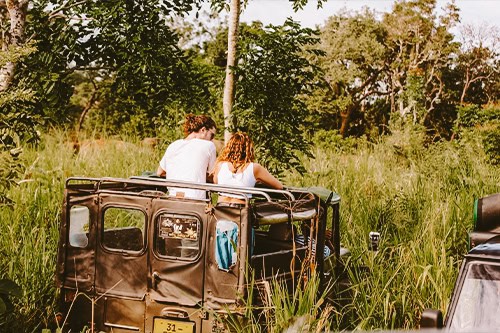
Touted as the prime destination for elephant sightings in the wild, the Minneriya National Park is set against a backdrop of evergreen forests, grassy plains, and wetlands that are home to a wide variety of bird and mammal species. Most travellers opt for a jeep safari in Minneriya to explore the country’s diverse landscapes while observing herds of at least 50 or more elephants during each visit.
Apart from its elephants, the park shelters 24 mammal species, including sloth bears, spotted deer, porcupines, toque macaques, and many more. It is also regarded as a birdwatcher’s paradise due to its 170 bird varieties, such as the migratory wood sandpiper and the rufous woodpecker, as well as Sri Lanka’s very own jungle fowl and brown-capped babbler.
However, much of Minneriya’s fame comes from its gathering of elephants during the dry season. As the waters of the Minneriya Reservoir subside, the elephants from the surrounding forests gather by the waterside to quench their thirst, creating a picture that is straight out of a postcard. More than 300 elephants may be seen frolicking in the wild during this time, making this the largest gathering of Asian elephants in the world.
The park is also somewhat known for its reservoir, which was constructed by King Mahasena in the 3rd century AD. Although the tank was neglected for several centuries, its repair was completed by the British in 1903, and it has become a vital source of water for the animals in the park ever since.
Generally, a jeep safari in the Minneriya National Park may take up to 3 or 4 hours to complete. While it is possible to embark on either a morning or afternoon safari, Travellers Isle recommends selecting the 2.30PM to 6.00PM safari to increase your chances of spotting more animals in the wild.
Please note that this excursion is best left for the dry season, which occurs between July and September, as this is when you will be able to witness Minneriya’s famed elephant gathering.

Despite its popularity as a tourist destination, Sigiriya is still considerably underdeveloped when compared with most other parts of Sri Lanka, and, in an attempt to preserve their culture, the local community of farmers now offer village tours. Not only do these tours offer insight into rural life, but they also provide an opportunity for travellers to experience the quaint charm of the countryside.
The typical village tour begins with a short bullock cart ride. As one of the country’s earliest modes of transportation, this humble cart will lead you off the beaten path, allowing you to witness the rustic beauty of the surroundings as the clopping of bulls’ hooves and birdsongs form an unending chorus in the background.
After this, you will be taken on a catamaran ride across a reservoir. As you paddle past water lilies and glimpse the splendid rock fortress from afar, you may even ask your guide for the oars to steer the boat yourself. Once you reach the opposite bank, you will be taken to a humble village of huts with thatched roofs for a culturally immersive experience.
The final stretch of a village tour involves a hearty meal of Sri Lankan cuisine at a simple village dwelling. Your host will use cooking appliances made of stone and wood to bring out the flavour of each dish. You will then be served a steaming pot of rice with creamy and spicy vegetable curries, topped with a generous helping of coconut sambol. This may be accompanied with sliced fruit that is grown in the village or ginger tea that is served in coconut shell cups.
While village tours are generally included when exploring Sigiriya with a travel agency, you will have to ask your hotel in the region for assistance in booking one of these tours if you are travelling solo. At most, a village tour may take up to 3 hours of your time, and a tuk-tuk will drive you back to the starting point when you are done.

Located a few kilometres away from the rock fortress is another rocky outcrop that towers over the surroundings, crafting an equally challenging hiking trail known as Pidurangala Rock. Stunning vistas of emerald forests and lush greenery mark the ascent, and travellers are rewarded with a stunning view of Sigiriya Rock at the top, easily making this one of the must-sees of the region.
Historically, Pidurangala’s origins can be traced back to the 5th century BC—a time when King Kashyapa relocated the monks who resided in the caves of Sigiriya Rock to a newer monastery in Pidurangala. It is also believed that this rock may have sheltered monks in seclusion for centuries before Kashyapa’s arrival.
Despite its historical value, Pidurangala is somewhat overshadowed by the grandeur of Sigiriya Rock, but there are several features that set it apart from the fortress. For example, the reclining Buddha statue on the first landing marks the remains of an ancient cave temple. This 12-meter-long statue rests beneath a giant boulder, and it is constructed entirely out of brick. However, parts of the statue have been renovated to preserve its appearance, which was destroyed by treasure hunters in the past.
That being said, Pidurangala is better known for an adventurous trek that resembles an obstacle course to some extent. Travellers must walk on stone steps, wriggle past rock formations, and heave themselves over huge boulders to reach the summit. As a reward for their efforts, they may enjoy magnificent views of the surrounding greenery that will make them feel as though they are at the top of the world.
A sunrise or sunset hike is ideal for Pidurangala Rock. If you wish to enjoy the sunrise at the peak, you may start your hike as early as 5AM, but a sunset hike will require setting off by 5PM. Most travellers complete the ascent and the descent in two hours, but the time that you spend at the summit is entirely up to you.
However, please note that this excursion is taxing on the body, so it is not recommended for small children and the elderly. Moreover, since a rock temple marks the start of the trail, you must comply with the temple dress code by concealing your bare arms, shoulders and legs. You will also be required to walk barefoot until you arrive at the stairs that signal the start of the hike.
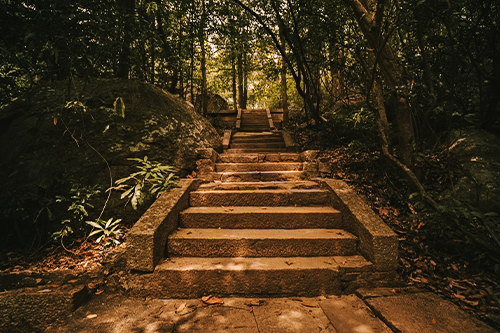
With its thick canopy of trees that provide shelter from the midday heat, the ruins of the Ritigala Forest Monastery stretch across 24 hectares on a mountain of the same name which doubles as a nature reserve. Rooted in a history that dates back to the 1st century BC, these monastic ruins proudly remain as a testament to Sri Lanka’s Buddhist heritage.
The story goes that the forest may have been inhabited by a group of enlightened monks who were led by the first ordained monk of the island, Aritta Thero. Under the rule of King Sena I, a total of 142 buildings were constructed in this monastery, but most of them were destroyed during the Chola invasions, and so, only their ruins remain.
There is plenty to see in the Ritigala Forest Monastery. For instance, the Banda Pokuna is a man-made, polygonal pool that was supposedly built by King Pandukabhaya (437-367 BC). Its closeness to the entrance suggests that it may have been used as a bathing pool for visitors in the past.
Yet another fascinating feature is the Janthagara (Steam Bath)—a section of hot stone baths in which the monks would bathe with herbal concoctions and slather themselves with medicinal ointments. On the other hand, the hillside Pothgula (Library) may have housed several Buddhist texts for the monks’ education.
A hike through the Ritigala Forest Monastery is best experienced with a local guide, who will be able to tell you about the history and mythology surrounding these ruins. Generally, this excursion can be completed in 2 to 3 hours, but it may take longer if you wish to explore everything that these ruins have to offer.
Please note that while the hike poses no difficulty for adults, it is not recommended for children who are below 10 years of age.
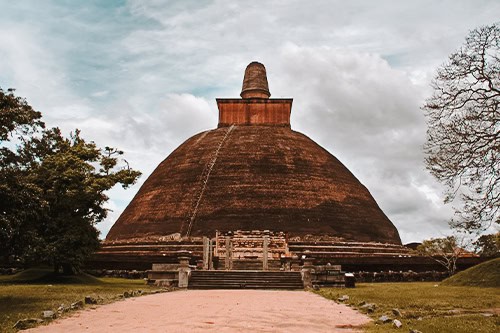
Both a UNESCO World Heritage Site and a sacred city, Anuradhapura stands as the first documented kingdom of the Sinhalese kings, and its ruins reflect the glory of a period in which Buddhism flourished on the isle. Most travellers opt for a day tour to Anuradhapura to explore its three monastery complexes and eight sacred sites, all of which offer valuable insight into Sri Lanka’s Buddhist heritage.
For instance, the heart of the city is home to one of the oldest living trees in the world—the Jaya Sri Maha Bodhi (Tree of Enlightenment), which was grown from a cutting of the fig tree that Lord Buddha meditated under before attaining enlightenment. Legend has it that the cutting was brought to the island by Princess Sangamitta, and it was presented to King Devanampiyatissa of Anuradhapura, who planted it in his royal park in 288 BC.
Among the other attractions that Anuradhapura is best known for, its most frequented stupa lies in the Maha Vihara monastery complex, where the chanting of Buddhist verses and offerings of flowers emphasize the devotion of the local community. Built by King Dutugemunu in the 2nd century BC, the Ruwanwelisaya stupa is one of the most sacred religious sites of its kind, as it contains the largest collection of Buddha relics.
On the other hand, the Jethawanaramaya stupa is located within a monastery complex of the same name, and it contains a part of the sash worn by Lord Buddha. Once known as the largest stupa in the world, it is believed to have measured up to 122 metres at its peak with a structure built out of 93 million bricks. The construction of this stupa is credited to King Mahasena and his son, Maghavanna I.
Apart from the attractions mentioned above, Anuradhapura is also known for Miriswetiya, Isurumuniya, the Twin Ponds, Thuparamaya, and the Samadhi Buddha Statue.
Travellers Isle recommends touring Anuradhapura with a knowledgeable guide for at least half a day. Since the sacred city can be toured by bicycle, most travellers schedule their tours from 8AM or 1.30PM onwards, as this is when the heat in the region is tolerable.
Please keep in mind that you must comply with the temple dress code during your tour. All visitors are advised to dress modestly by concealing their bare arms, shoulders and knees to gain entry.
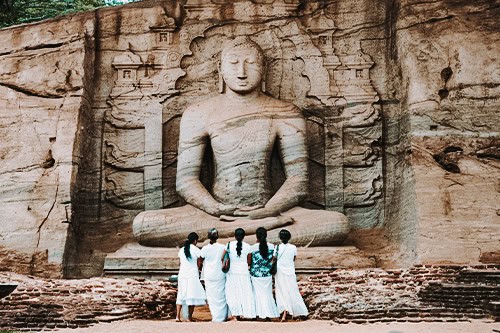
Following the destruction of Anuradhapura by the Chola invaders in 993, Polonnaruwa was elevated to the second Sinhalese kingdom on the isle—a feat that was made possible by King Vijayabahu I, who defeated the invaders and restored peace to the land. Now a UNESCO World Heritage Site, this ancient city contains various landmarks of Buddhist origin, making it the ideal destination for a historical tour.
Among its many attractions, the Vatadage (Circular Relic House) was supposedly built during the reign of Parakramabahu I for the protection of the sacred tooth relic. Its circular shape mimics the cyclic nature of birth, death, and rebirth, whereas the intricate carvings of flowers, elephants, and mythological creatures on its guardstones and moonstones highlight the craftsmanship of ancient artisans.
There is also a stone slab known as the Velaikkara Inscription, which bears ancient Tamil and Sinhala letters. The first part describes the benevolence of Vijayabahu I, and the second contains the pledge of the South Indian Tamil mercenaries, better known as the Velaikkara soldiers, to protect the Tooth Relic.
Apart from these features, Polonnaruwa is also renowned for the Lankathilaka Image House, which draws attention to the mastery of Sri Lanka’s artisans. Built in an architectural style that reflects India’s influence on the country, the walls of this structure are adorned with religious figures, but their splendour is overshadowed by the majestic standing statue of the Buddha.
Along with the attractions mentioned above, Polonnaruwa is also known for the Gal Vihare, Quadrangle, Thivanka Image House, and the Nissanka Latha Mandapaya.
Most travellers tour Polonnaruwa by vehicle, as this allows them to cover more of its attractions in a shorter time. Travellers Isle recommends exploring this ancient city with a knowledgeable guide for at least half a day, ideally in the early morning or the late afternoon to avoid the blistering heat.
Please note that you must comply with the temple dress code during your tour. All tourists are advised to wear modest clothes that conceal their bare arms, shoulders and knees in order to gain entry.
Frequently Asked Questions
1. Is Sigiriya worth visiting?
Definitely. At first glance, the little town of Sigiriya may not seem very remarkable, but it gets its fame from the ancient fortress that towers over its landscape as well as its convenient location, which allows travellers to access other parts of the cultural triangle with ease.
The fortress and village tour are two attractions that are experienced within Sigiriya itself. In particular, the rocky outcrop of the fortress stands as a reminder of the island’s centuries-old history under the rule of the Sinhalese kings, and hikers are able to acquaint themselves with the rustic beauty of the region during their climb. On the other hand, its village tours are culturally immersive experiences that support the livelihood of the rural community while preserving the local culture.
Moreover, Sigiriya is well worth a visit because of its closeness to the other parts of the cultural triangle—a fact that has encouraged many to base themselves in the region. Travellers are thus able to return to their hotel in Sigiriya without changing their accommodation after exploring Anuradhapura, Dambulla and Polonnaruwa during the day.
This convenience makes it easy to embark on a jeep safari in Minneriya, where wildlife enthusiasts may spot elephants and other animals in the wild. Alternatively, travellers may engage in some spiritual reflection as they uncover ancient history in the statues and murals of the Dambulla Cave Temple.
History buffs may also venture to Anuradhapura and Polonnaruwa to learn more about the Sinhalese kings and their devotion to Buddhism. On the other hand, Pidurangala Rock and the Ritigala Forest Monastery provide an opportunity to discover Sri Lanka’s distant past while hiking through the diverse landscapes of the country.
Collectively, these attractions make Sigiriya well worth a visit during your stay, and they have established Sigiriya’s status as one of Sri Lanka’s prominent tourist destinations.
2. How long do you need in Sigiriya?
A minimum of 2 nights in Sigiriya are necessary to enjoy the region’s main attractions at a leisurely pace. However, if you have ample time to spare and you wish to experience everything that the cultural triangle has to offer, you may extend your stay to 3 or 4 nights.
3. When to visit Sigiriya Sri Lanka?
Although Sigiriya is accessible all year round, it is best visited from mid-December to mid-April, and from July to September. These two periods are considerably dry, so your chances of experiencing rainfall are less, but if you wish to see the famed gathering of elephants in Minneriya during your stay, it is best that you schedule your visit between July and September.
Travellers Isle recommends against touring Sigiriya in May, June and November, as this is when torrential downpours are expected island-wide.
4. Can you stay in Sigiriya?
Of course. Despite its rural appearance, Sigiriya has a range of accommodation options that take the needs of every traveller into account. Its collection of luxury hotels and budget guesthouses are scattered in convenient locations which make Sigiriya the ideal base for tours in the cultural triangle.
More Tips for Your Holiday

"We have had our amazing driver taking us around Sri Lanka with our 15 month old daughter for the last two weeks. Everything has been organized for us and everything has been perfect.Anyone thinking about going to Sri Lanka with their little ones should book with Travellers Isle. Nothing has been too much trouble for them. All hotels have been fabulous and our driver has been so helpful, amazing with our daughter, professional and knowledgeable."

